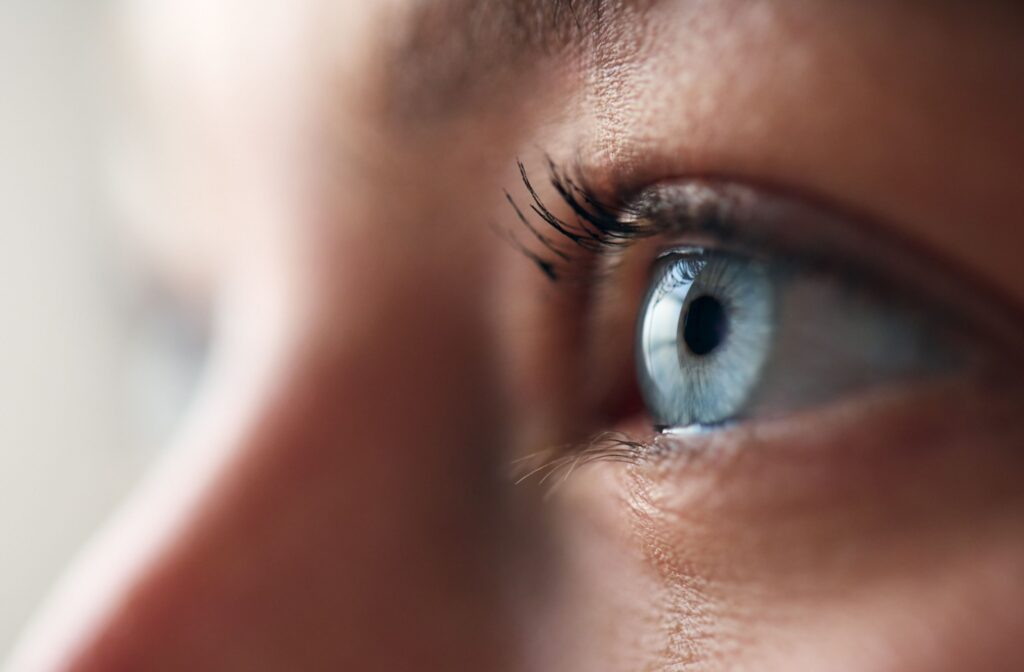You probably know whether you’re right-handed or left-handed, but have you ever thought about having a dominant eye? Your brain naturally prefers visual input from one eye over the other, just like it prefers one hand for writing. This is a common and completely normal trait that helps you process visual information as part of our proactive approach to eye care.
Your dominant eye is the one your brain relies on more for accurate visual information, and you can find it with a couple of simple at-home tests. It’s the eye that takes the lead in telling your brain about the location and position of objects.
Knowing which eye is dominant can be a fun piece of information and even helpful for certain activities, which is something we can discuss during a routine eye exam.
What Is a Dominant Eye?
Your dominant eye is the one your brain relies on a little more for visual information. Think of it like having a dominant hand you prefer to write with. It simply means one eye takes the lead to send information to your brain about the location of objects.
The Different Types of Eye Dominance
Your brain might prefer one eye over the other for different tasks. There are a few ways to think about eye dominance, and each one describes a different way your eyes and brain work together.
- Sighting Dominance: This is the eye you prefer to use when you aim or look at a specific target.
- Sensory Dominance: This refers to the eye your brain trusts more when each eye sees a slightly different image.
- Acuity Dominance: If one eye sees more clearly than the other, which can be due to various reasons for worsening eyesight, your brain may favor it in some situations.
Simple Tests to Find Your Dominant Eye at Home
You can find your sighting-dominant eye with a couple of easy tests. You won’t need any special tools, just your hands and an object across the room. These methods are quick and can give you an answer in minutes.
The Triangle Method
- Extend your arms out in front of you.
- Create a small triangle-shaped opening with your thumbs and index fingers.
- With both eyes open, look through the triangle and center it on a distant object, like a doorknob.
- Close your left eye; if the object stays in the triangle, your right eye is dominant.
- If the object moves out of the triangle when you close your left eye, then your left eye is dominant.
The Thumb Method
- Extend one arm straight out and point your thumb up.
- With both eyes open, focus on a distant object and place your thumb over it.
- Close one eye at a time.
- The eye that keeps your thumb directly over the object is your dominant eye.
Eye Dominance & Handedness
Most people who are right-handed are also right-eye dominant, but it’s not always the case. Your eye dominance and hand preference develop separately from each other. So, it’s entirely possible to be right-handed and left-eye dominant.
What Is Cross-Dominance?
Cross-dominance happens when your dominant eye is on the opposite side of your dominant hand. For example, you might be right-handed but left-eye dominant. This is a common trait and happens in a large portion of the population, sometimes affecting hand-eye coordination in specific tasks.
How Common Is Left Eye Dominance?
Right-eye dominance is more common, but having a dominant left eye is not rare at all. About two-thirds of the population is right-eye dominant. This means that around 30% of people are left-eye dominant.

Why Your Dominant Eye Matters
For most people, knowing their dominant eye is just a fun fact. However, it can be useful information for certain activities and vision treatments. Understanding how your eyes work together can even help with some hobbies.
For Sports & Hobbies
Knowing which eye leads can help improve your performance in activities that require aiming at a target, as vision and sports performance are closely linked. It gives you a small but helpful advantage when precision is key.
- Photography: Use your dominant eye to look through the camera’s viewfinder for a more accurate shot.
- Baseball & Softball: Batters can adjust their head position to let their dominant eye track the ball.
- Golf: Aligning your body for a putt is easier when you use your dominant eye to see the line.
- Shooting Sports: Awareness of your dominant eye helps improve accuracy, especially if you have cross-dominance.
For Your Vision Correction
We use information about eye dominance for certain types of vision correction. With monovision—a technique used with contact lenses or vision correction procedures—one eye is corrected for distance vision and the other for near vision. Your dominant eye is typically the one we correct for seeing things far away.
What If You Don’t Have a Dominant Eye?
In some cases, a person may not show a strong preference for one eye over the other. This is sometimes called mixed or alternating ocular dominance. One eye may be dominant for certain tasks and the other eye takes over for different ones, but this is less common and is not a cause for concern.
When to Discuss Eye Health with an Eye Doctor
While eye dominance is a normal part of how your vision works, a comprehensive eye exam can tell you much more. During a routine visit, you can discuss any questions you have about your vision. If you’re looking for an eye doctor in Diamond Bar, a check-up is a great way to stay informed about your overall eye health.
Schedule a visit with us at Total Vision Diamond Bar to learn more about your eye health.



